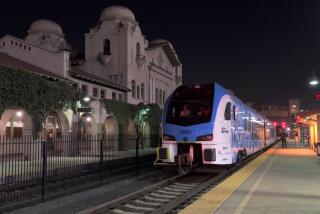Diesel Trains Would Add to Smog--Study
Commuter trains pulled by diesel locomotives would create more pollution--twice the amount of one kind of noxious gas--than all of the automobiles they are projected to take off the freeways, a study commissioned by Southern California Edison Co. has found.
Local transit officials are skeptical of the reportâs assumptions and conclusions, which were given to the California Transportation Commission last week as part of an analysis of electric-powered vehicles.
They acknowledge that the report has given urgency to previously private negotiations between the utility and Los Angeles County Transportation Commission about electrifying 130 miles of commuter train lines the commission plans to open next year. As part of regional rail plans for future years, Orange County has joined with Los Angeles County in ordering dozens of diesel locomotives for such trains, which may traverse the county as many as 18 times a day. Already diesel locomotives haul Amtrak intercity trains and one Orange County Transportation Authority commuter train on the route.
âThe assumption always has been that the more cars you get off the road, the better off you are,â said Richard Schweinberg, manager of electric transportation research at Edison. âOur study indicates this is not necessarily trueâ for all pollutants.
âWhat theyâve come up with flies in the face of what has been found in other cities . . . (where), on balance, diesel locomotives are far more beneficial than the cars they replace,â said Richard Stanger, manager of commuter rail trains at LACTC. âSomething is strange. Something is wrong and we have to find out what it is.â
Orange County transportation officials said they would not comment on Edisonâs findings until after LACTC has had a chance to analyze the data.
The state Transportation Commission has asked Edison to meet with the Los Angeles county commission and other government agencies on Aug. 20 to review the studyâs findings and consider Edisonâs tentative offer to pay the $80-million cost of electrifying the commuter rail network.
The LACTC, in cooperation with similar agencies in Orange, San Bernardino, Riverside and Ventura counties, is racing to buy old and marginal freight railroad tracks, upgrade them to passenger standards and build stations in time to launch commuter service by November, 1992.
Three lines would radiate from Los Angeles Union Station to Moorpark in Ventura County, the Santa Clarita Valley and San Bernardino. Together, they are projected to carry 10,600 passengers a day.
The lines, it was assumed, also would ease the regionâs air pollution by taking a similar number of automobiles off the road. The Edison study confirmed that, compared to cars, the trains would emit 90% less of one class of smog components, reactive organic gases. But the diesel-burning locomotives unexpectedly would double the amount of another pollutant, oxides of nitrogen.
âIt would be like adding 11,000 or 12,000 cars to the roadâ in terms of that pollutant, said Schweinberg. âWe were just as surprised as the next guy.â
Stanger said he still believes that the diesel locomotives will prove cleaner than cars.
âWe donât think those (Edison) numbers are correct,â he said. âOur locomotives have specifically been designed to be more fuel efficient--and therefore put out fewer pollutants--than other locomotives.â
More to Read
Sign up for Essential California
The most important California stories and recommendations in your inbox every morning.
You may occasionally receive promotional content from the Los Angeles Times.










